
eBook - ePub
City Walks: Chicago
50 Adventures on Foot
Christina Henry de Tessan
This is a test
Share book
- 50 pages
- English
- ePUB (mobile friendly)
- Available on iOS & Android
eBook - ePub
City Walks: Chicago
50 Adventures on Foot
Christina Henry de Tessan
Book details
Book preview
Table of contents
Citations
About This Book
Stroll the Magnificent Mile and more with fifty Chicago walking tours. Explore Chicago like a native with this convenient ebook offering maps and information to guide you through numerous enjoyable and enlightening walks that highlight both the history of this Midwestern city and the shopping, dining, and nightlife it offers. Discover landmarks like Millennium Park, the Loop, the Magnificent Mile, and Navy Pier—along with the many lesser-known local delights along the way!
Frequently asked questions
How do I cancel my subscription?
Can/how do I download books?
At the moment all of our mobile-responsive ePub books are available to download via the app. Most of our PDFs are also available to download and we're working on making the final remaining ones downloadable now. Learn more here.
What is the difference between the pricing plans?
Both plans give you full access to the library and all of Perlego’s features. The only differences are the price and subscription period: With the annual plan you’ll save around 30% compared to 12 months on the monthly plan.
What is Perlego?
We are an online textbook subscription service, where you can get access to an entire online library for less than the price of a single book per month. With over 1 million books across 1000+ topics, we’ve got you covered! Learn more here.
Do you support text-to-speech?
Look out for the read-aloud symbol on your next book to see if you can listen to it. The read-aloud tool reads text aloud for you, highlighting the text as it is being read. You can pause it, speed it up and slow it down. Learn more here.
Is City Walks: Chicago an online PDF/ePUB?
Yes, you can access City Walks: Chicago by Christina Henry de Tessan in PDF and/or ePUB format, as well as other popular books in Développement personnel & Voyage. We have over one million books available in our catalogue for you to explore.
Information
Subtopic
Voyage1
MILLENNIUM PARK
Although it wasn’t quite ready for the millennium, this outstanding addition to the cityscape was worth the wait. Featuring modern sculptures, a Frank Gehry–designed music pavilion, and a skating rink, Millennium Park is not to be missed.
Bus: 4, 60, 145, 147, 151. El: Randolph (Brown, Green, Orange lines).
Begin at N. Michigan Avenue and E. Randolph Drive. Enter the park from Michigan, stopping at the Wrigley Square Monument (1), a fountain and half-circle of columns representing the peristyle that was once located here. Continue south across the lawn. Ahead of you is the McCormick Tribune Plaza and Ice Rink, where crowds gather in the summer to dine on the outdoor terrace of the Park Grill Restaurant and in the winter months to skate. Turn left onto the pathway leading to the Chase Promenade, where you’ll come upon Anish Kapoor’s magnificent Cloud Gate sculpture (2), whose circular shape stands in fabulous contrast to the linear buildings behind it. Past the plaza, turn right and walk to the Crown Fountain (3), an interactive sculpture that displays a changing array of faces on its glass towers. Turn back toward the park’s center. On your left, beyond the Great Lawn and underneath a steel trellis, you’ll see the fantastical Jay Pritzker Pavilion (4) designed by Frank Gehry. To your right is the Lurie Garden (5), which is divided into several sections, each representing a different facet of Chicago’s evolution. Continue north along the far edge of the Great Lawn and detour onto the whimsical BP Bridge (6), which swirls over Columbus Drive. To exit the park, return to the path skirting the Great Lawn and continue north past the Pritzker Pavilion and turn left at the black cube-shaped Exelon Pavilion to return to your starting point.

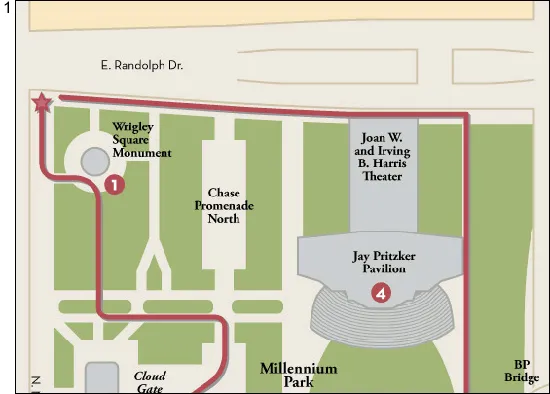
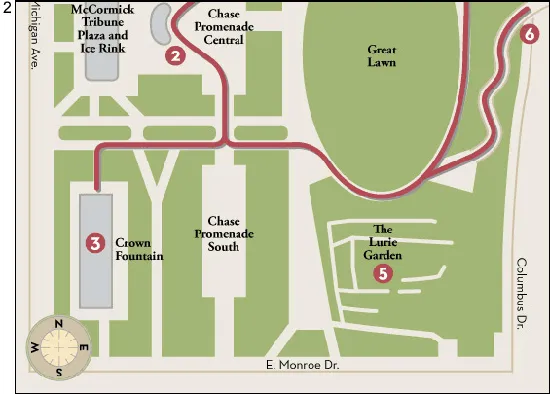
2
GRANT PARK
Grant Park consists of 319 acres of green space on prime real estate between Lake Michigan and downtown. During the summer months, it hosts countless festivals and concerts that draw immense crowds. At other times, tourists, college students, and joggers find the park a pleasant reprieve from the surrounding urban frenzy.
Bus: 4, 60, 145, 147, 151. El: Randolph (Brown, Green, Orange lines).
Begin at Daley Bicentennial Plaza on E. Randolph Drive. Descend down the paved walkway into the park, detouring toward the lake to stroll through the serene Cancer Survivor’s Garden (1). Cross E. Monroe Drive at the Columbus Drive intersection (in the warmer months, you’ll pass an outdoor café and miniature golf course here). Continue south across the vast expanse of Butler Field and past the Petrillo Music Shell, where big concerts and festivals take place. After crossing E. Jackson Drive, cross through a lovely little rose garden to arrive at the majestic Buckingham Fountain (2). Take a loop around this grand esplanade, which affords the visitor views of the Chicago Harbor to the east, Adler Planetarium to the south, and the exquisite skyline to the north and west. With three pink marble basins and a central jet shooting water up to 137 feet in the air, the 80-year-old fountain was once the world’s largest. From May through October, water displays and evening light shows take place regularly. In the right weather, you can linger a while at the nearby Café and Grill. Continue south through the planted gardens and cross Lake Shore Drive at E. Balbo Drive. Head south along the waterfront, admiring the harbor views and boats scudding along the water. End at E. Roosevelt Drive.

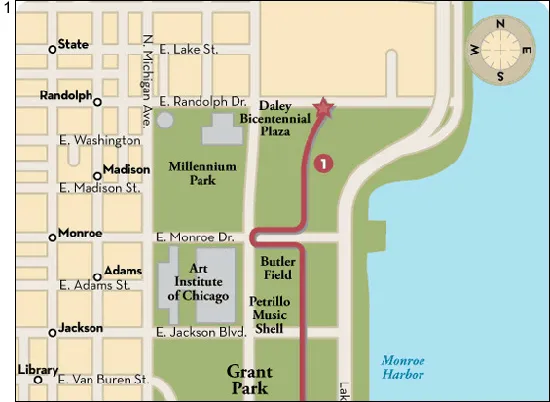

3
THE ART INSTITUTE OF CHICAGO
It is impossible to do justice to the Art Institute’s world-class collection in so little space. Here are just a few logistical details to get you started.
Bus: 3, 4, 6, 7, 14, 126, or 151. El: Adams (Brown, Green, Orange lines).
Begin in front of the Art Institute (111 S. Michigan Avenue). Before entering the building, note the two bronze lions sculpted by Edward Kemeys in 1894. Today they are a beloved symbol of the city, and are decorated on special occasions. Detour to the Stanley McCormick Memorial Court north of the entrance to view Sir Henry Moore’s Large Interior Form and Alexander Calder’s Flying Dragon. Inside, at the information desk, you can obtain a free map and information on guided tours and audio guides. (Note: Admission is free on Thursday evenings throughout the year and Friday evenings during summer. Music, cocktails, and hors d’œuvres are all offered on those nights, Memorial Day through Labor Day.) The vast collection can be overwhelming, so it’s probably best to focus on just a few areas. The European impressionist and postimpressionist collection (Second Level) is among the most popular, with well-known works by Monet, Caillebotte, Renoir, and Seurat. The spectacular American collection (First and Second Levels) includes Edward Hopper’s famous Nighthawks. Other highlights include the Asian collection (First Level), the photography collection (Lower Level), the re-creation of the Chicago Stock Exchange Trading Room (First Level), and the Kraft Education Center for kids (Lower Level). The museum shop (First Level) stocks elegant souvenirs, and a meal at the Garden Restaurant (Lower Level) is a lovely way to wrap up your visit; locals come for live jazz on Thursday evenings in July and August.

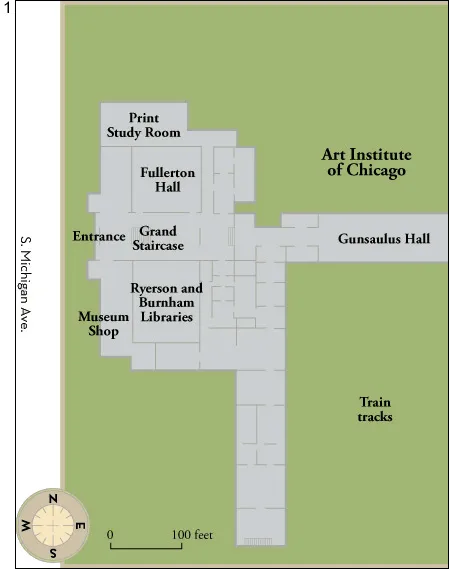

4
MUSEUM CAMPUS
Chicago is home to a mind-boggling variety of cultural institutions. Conveniently for visitors, Adler Planetarium, Shedd Aquarium, and the Field Museum of Natural History are clustered together. They are sure to intrigue and delight kids and adults alike.
Bus: 6, 12, 14, 146. El: Roosevelt (Green, Orange lines).
Begin at Roosevelt Road and Columbus Drive. Walking toward the lake, descend the wide pedestrian walkway at the northeast corner of the intersection, next to the statue of Columbus. Go through the underpass, turning left in the direction of Shedd Aquarium (1). The world’s largest indoor aquarium also includes an oceanarium, with beluga whales among its many impressive exhibits. After visiting the aquarium, loop around to the north side of the building and stroll along the waterfront esplanade toward Adler Planetarium & Astronomy Museum (2) at its far end. Stop in for lunch at Galileo’s Café and enjoy what many consider to be the best view of Chicago’s skyline. The planetarium, the nation’s first when it opened in 1930, has a variety of shows in its two theaters as well as several riveting exhibits. After your visit, stroll around the planetarium to the stone sculpture called America’s Courtyard (3) on the south side. A plaque explains how it can be used to chart the progress of the seasons. Head back toward the mainland along Solidarity Drive, the central promenade. Once you reach the Field Museum of Natural History (4), turn left on Museum Campus Drive and right on McFetridge Drive to reach the front entrance. Although the Field Museum is best known for Sue, the world’s largest and most complete Tyrannosaurus rex fossil, it has countless other wonders in its collections. When you’re done here, catch the bus on McFetridge Drive.

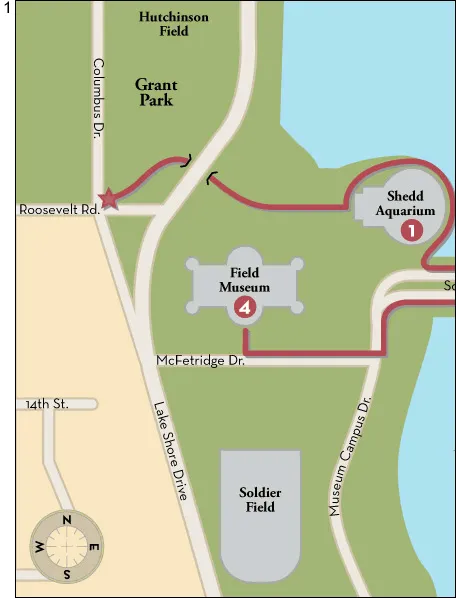

5
MICHIGAN AVENUE SOUTH OF THE CHICAGO RIVER
One of Chicago’s early claims to fame was its ambitious architecture. The structures along this stretch were mostly built before the advent of steel-beam construction, which allowed for the construction of skyscrapers—much taller, but less ornate, than the buildings here.
Bus: 3, 6, 145, 146, 147, 151, 157. El: State (Brown, Green, Orange lines).
Begin at the southern end of the Michigan Avenue Bridge (1). A pillar to the left of the southern post of the bridge commemorates the site of Fort Dearborn, the nation’s westernmost outpost in 1803, a fascinating contrast to the skyscrapers looming all around you. Head south on N. Michigan Avenue. The Carbide and Carbon Building (2; 230 N. Michigan Avenue) is one of the city’s better known art deco buildings. Note its green terra-cotta tower and gold leaf detailing. Continue south, passing Millennium Park on your left. You’ll come upon the Chicago Cultural Center (3; 78 E. Washington Street), built in 1897. Today, this architectural marvel ...